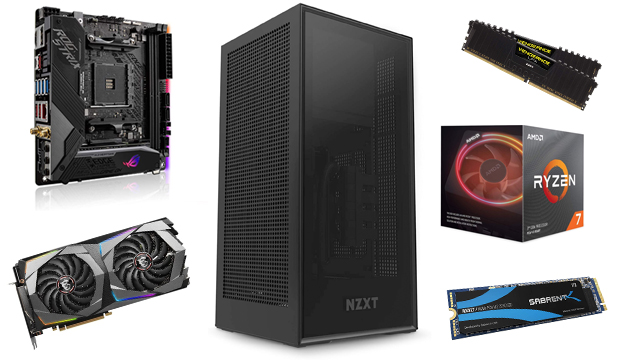The Xbox Series X is shaping up to be an incredibly powerful console, boasting performance many times better than the current-gen Xbox One. It’s sure to be impressive by modern console standards, however, when it comes to the ultimate gaming experience on the most powerful platform, gamers will still need to look towards PC. Introducing our “Xbox Series X Killer” PC build guide, which combines a modern small form factor look with powerful internals that will let you game, stream, and do just about anything else. Let’s pit the Xbox Series X vs PC!
Xbox Series X Killer PC | Parts List
Case/Cooler/Power Supply – NZXT H1

Let’s knock the case, cooler, and power supply out in one go. The NZXT H1 is the component that first inspired this Xbox Series X Killer PC build, as it sort of looks like the new Xbox, albeit with a
tempered glass front panel. A high-quality liquid CPU cooler comes included with the H1, along with a capable power supply.
In our review of the NZXT H1, we praised it for being ridiculously easy to build in. Cables are pre-routed and ready to be plugged in, meaning the entire PC build should really only take 20-30 minutes for a reasonably competent builder, with up to an hour for a total beginner working alongside the helpful NZXT tutorial.
While small form factor PCs have always looked cool, they have been notoriously tricky to fit components into, especially when it comes to cooling and the graphics card. With the H1, this isn’t an issue, as it comes with a cooler and is compatible with a wide range of graphics cards.
CPU – AMD Ryzen 7 3700X

The brain of our Xbox Series X is the AMD Ryzen 7 3700X. When it comes to bang for the buck, while still matching the new Xbox in core count, the Ryzen 7 3700X is a fantastic choice. Its 8 cores and 16 threads make it a powerhouse for more intensive applications like streaming and video editing, and its gaming performance is hugely improved over previous AMD components.
The 3700X is my personal daily driver for handling a huge number of windows and tabs, simultaneously gaming and livestreaming, as well as photo and video editing using Adobe software. If this use case sounds familiar to your workflow, then you’ll also want to consider the 3700X.
The cheaper Ryzen 5 3600 is incredibly popular right now, and though it’s a step down from the 3700X we’re including in this build, it’s also certainly a great choice. On the flip side, for users demanding more power, AMD’s 3800X, 3900X, and 3950X all take things to the next level and have been proven to work inside the NZXT H1 with the provided cooling.
You could also go with Intel, with its 10th gen CPUs having just launched alongside Z490 motherboards.
Motherboard – ASUS ROG X570-I Strix

With our Xbox Series X killer PC build, we’re limited to Mini-ITX motherboards. Thankfully, there are a number of great options available. We’re going with the ASUS ROG X570-I Strix, as it
includes bells and whistles that go nicely with the Ryzen 7 3700X we’re using as the CPU.
Alternatively, to save a buck, you can opt for a B450 motherboard. These might not boast the same overclocking potential as the X570 boards, but they will still get the job done for basic use and beyond. Any money saved can be put towards more storage or a better graphics card.
AMD has a great track record of supporting the same sockets across multiple product generations, meaning when new CPUs come out, our ASUS X570 motherboard is likely to still support them. This saves you a buck when upgrading and makes the whole process super simple.
RAM – Corsair Vengeance LPX 16 GB DDR4-3600 C18

When it comes to RAM in our Xbox Series X killer PC build, we’re going to hunt for the cheapest DDR4 memory available with 3600 MHz speeds or above. While you can certainly use slower RAM in your build, Ryzen CPUs are able to flex their muscles with higher clocked memory.
Inside the NZXT H1, you won’t see much from RAM RGB lighting, so it’s not a priority here. Focus on getting the cheapest sticks from a brand you trust.
At the time of writing, that means the Corsair Vengeance LPX 16 GB DDR4-3600 C18 will be our RAM of choice for this build.
Graphics Card – GeForce RTX 2070 SUPER

As mentioned in the Case section, the NZXT H1 supports a wide range of full-size graphics cards, with the limits being 305mm x 128mm; 265mm x 145mm, supporting up to 2.5 slot cards. This means that you could fit the highest-end gaming card, the Nvidia RTX 2080 Ti in this system!
However, for this build and considering current pricing, we’re going to go with the RTX 2070 Super, which is a great GPU for competitive 1080p/1440p high frame-rate experiences, as well as being capable at 4K for immersive single-player titles.
In addition to being a gaming powerhouse, the Nvidia RTX 2070 Super also supports ShadowPlay, which lets you capture gameplay; RTX Voice, which reduces background noise from your microphone; Ansel, for awesome screenshots; as well as ray-tracing, to make games look even better.
Though you can step things up to the RTX 2080 Super and beyond, we’re going to save that additional budget for future upgrades, to ensure our Xbox Series X killer PC truly delivers on better performance with an upgrade to Nvidia’s rumored 3000 series cards.
Storage – Sabrent 1TB Rocket NVMe PCIe M.2

You’ve probably heard about the super-powered SSDs that the Xbox Series X and PS5 are bringing to the table. Sure, these are impressive, but you can already get some pretty damn speedy storage on the PC side.
With our Xbox Series X killer PC build, we’ll be going with a Sabrent 1TB X M.2 SSD. There are cheaper M.2 options available, but you’ll want to make sure you’re choosing an NVME drive, so as not to be limited on speed.
The Crucial P1 is another good option if the Sabrent drive is out of stock or the price has been inflated due to demand.
The NZXT H1 case also has room for two 2.5” drives, so you can throw in some less modern, but still very fast, standard SSDs for additional storage space.
Xbox Series X Killer PC | Future-proofing

That’s our Xbox Series X killer PC built and ready to get you playing next-gen now, in addition to everything else you can do on a PC!
One of the biggest benefits of owning a PC over a console is the upgradability. While the Xbox Series X might seem impressive at launch, it’s only a matter of time before its specs become outdated and hold it back when playing the latest games. With our killer PC build, we can upgrade over the years, to keep it running at a god-tier level.
Even inside a small form factor case, we’ll be able to upgrade the CPU to enjoy more cores and threads, as well as higher clocks, and whatever else AMD includes in future components. Then there’s the GPU, which can easily be swapped out for something more powerful in the future. Storage options can also be upgraded when prices drop even further, which could be a big win over the expensive proprietary storage that the next-gen consoles will likely be using.











